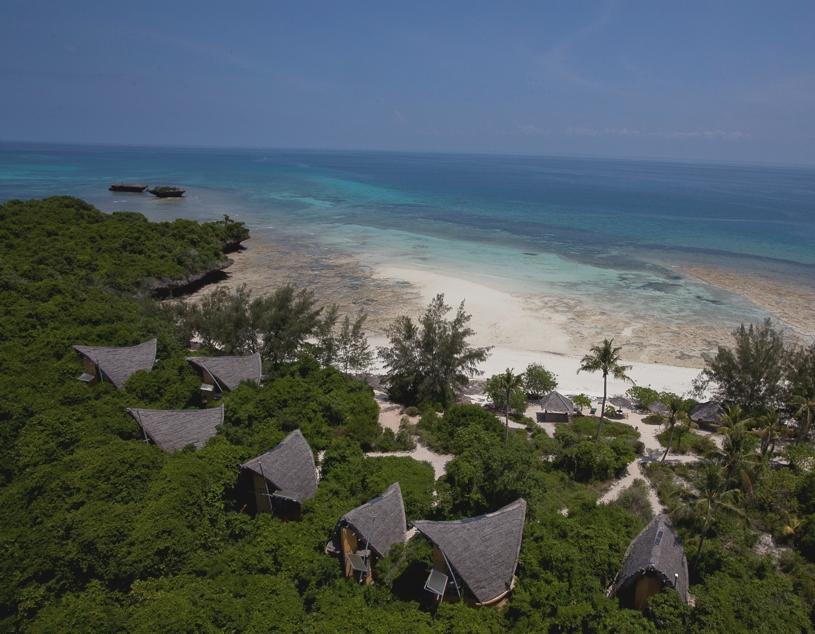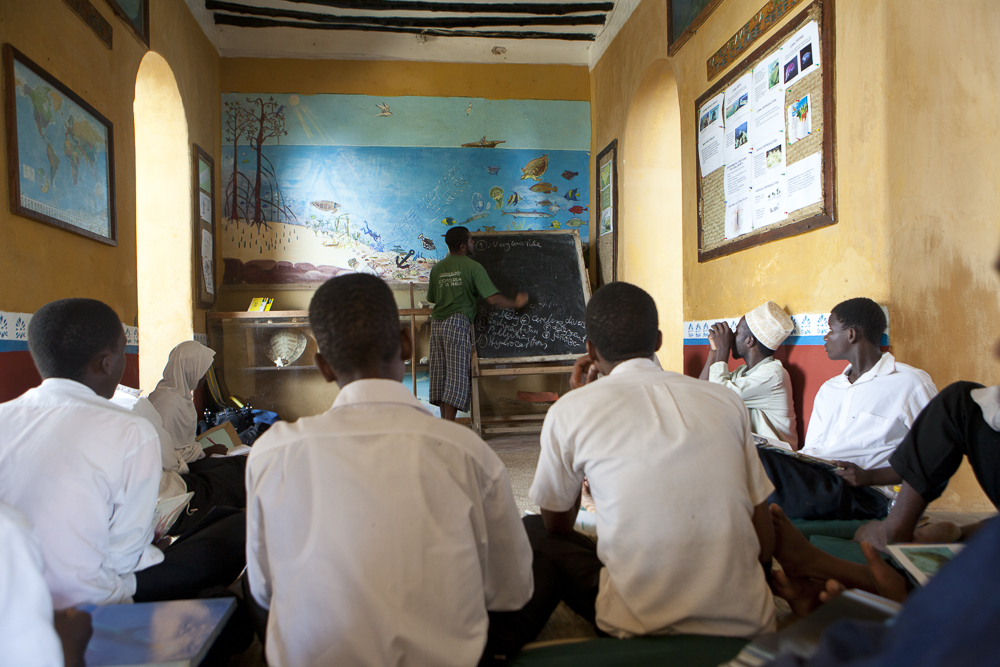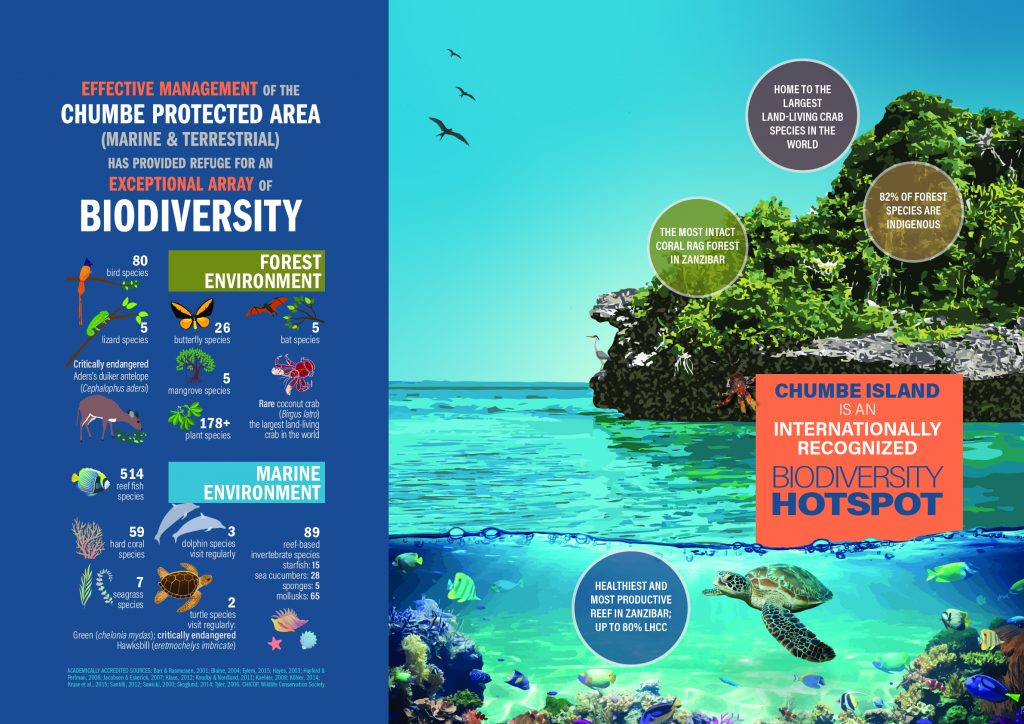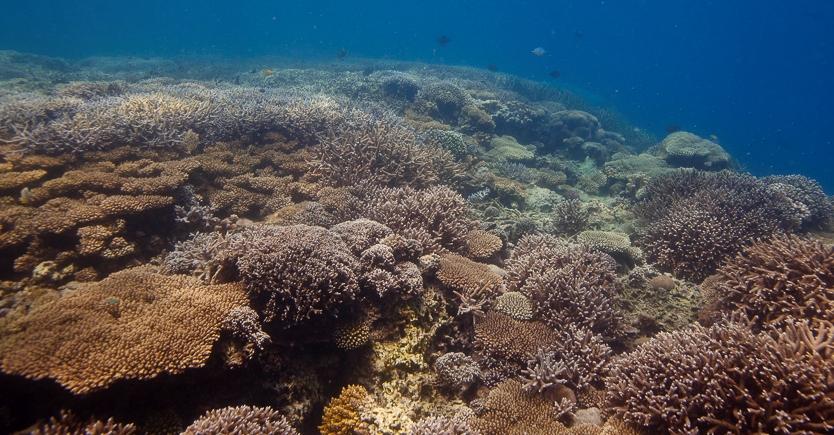The Establishment of a Marine Eco-Park to Conserve Reefs and Support Environmental Education in Tanzania
Location
Chumbe Island, Zanzibar, Tanzania
The challenge
Chumbe Island is a small coral island in East Africa just west of the island of Zanzibar, Tanzania. The Chumbe Reef Sanctuary has been recognized as one of the most diverse in East Africa, with at least 59 hard coral genera, 514 reef fish species, the critically endangered hawksbill sea turtle (Eretmochelys imbricata) and the endangered green sea turtle (Chelonia mydas). A botanical survey on the island in 2021 confirmed there are 178 plant species belonging to 159 genera; 82% of which are considered indigenous. The island’s coral rag forest holds important biodiversity value within the East African coastal forests. The coastal forests are home to even more threatened and endangered species, such as the Aders’ duiker antelope (Cephalophus adersi), coconut crab (Birgus latro), and various species of birds and reptiles.
The western reef of Chumbe Island has been traditionally closed to fishing due to its proximity to the shipping channel between Zanzibar and mainland Tanzania. Still, overfishing and destructive fishing practices like dynamite fishing, smashing corals to encircle fish in nets, and beach seining are common in the area. With rapid population growth and the advent of mass tourism in Zanzibar, coral reefs are under pressure from overfishing, poaching, and the use of illegal fishing methods. The situation in Zanzibar is not uncommon for developing countries in the tropics: insufficient capacity for effective marine governance and enforcement, poverty, and lack of alternative livelihoods make it difficult to balance a sustainable environment and a sustainable community.
Actions taken
Recognizing the high levels of biodiversity in both reef and forest habitats, Sibylle Riedmiller, a conservationist and former aid worker, spearheaded the establishment of Chumbe Island Coral Park (CHICOP) in 1992 that encompasses the uninhabited island and surrounding marine habitat. The focus was to create a marine park where profits from tourism would help support conservation and environmental education. Ms. Riedmiller further realized that to reduce fishing pressure on the reef ecosystem, she could offer local fishermen employment as park rangers, who would also be trained to educate fellow fishers about the spillover effect of a no-take zone that could benefit them by restocking adjacent overfished areas and thus increase catches.
Today, CHICOP includes the fully protected 55.06 hectare Chumbe Island Reef Sanctuary with coral reef, pelagic, shallow coastal, and intertidal habitats; a 16.64 hectare coral rag forest reserve (Closed Forest Reserve), a visitor’s center; a small eco-lodge; nature trails; and historic monuments. Any extractive uses such as fishing, anchoring, and the collecting of specimens (even for research) are prohibited. Recreational and educational activities such as swimming, snorkeling and underwater photography are permitted. The mission statement for Chumbe Island Coral Park is:
“To manage, for conservation and educational purposes, the Chumbe Island Reef Sanctuary and the Forest Reserve. This is also supported by eco-tourism activities which are directly related to the non-consumptive uses of the natural resources.” (COMPANY ARTICLES OF ASSOCIATION, S:3, 1994)
CHICOP’s operation vision:
The Chumbe Island Coral Reef Sanctuary and Closed Forest Reserve are effectively and sustainably managed in order to maximize their contribution to biodiversity conservation, serve as a model for effective ecotourism and MPA management, and provide a platform to promote wider environmental awareness for sustainable development and ecological stewardship in Zanzibar. (3rd CHICOP MANAGEMENT PLAN, 2017)
How successful has it been?
CHICOP has become a successful ecotourism destination and an internationally recognized conservation success. As of 2022, the Park employs and trains 41 local people from Zanzibar (95% of total staff) for positions such as park rangers, guides, educational specialists, and hospitality workers. The rangers and guides, eight of whom are former fishers, educate fishermen about the importance of coral reefs and of a small no-take zone as a breeding sanctuary for fisheries. As a result, CHICOP has been able to demonstrate that protection of the Chumbe reef helps restock overfished reefs several kilometers beyond the waters of the sanctuary.
Chumbe Island has won many prestigious international awards and become a center of exceptional biodiversity, as demonstrated by the breeding activities of many endangered and rare species. The Forest Reserve is the last undisturbed semi-arid ‘coral rag’ forest in Zanzibar, particularly after successful rat (Rattus rattus) eradication in 1997. With support from the Zoo Munich-Hellabrunn, Flora and Fauna International, and the Chicago Zoological Society, a translocation program in 1999 made Chumbe Island a sanctuary for highly endangered endemic Aders’ duikers (Cephalophus adersi), which are threatened by poaching and habitat destruction elsewhere in Zanzibar. Chumbe also harbors the world’s largest known population of rare coconut crabs (Birgus latro). Attracted by abundant fish in the reef sanctuary, locally rare Roseate terns (Sterna dougallii) bred on Chumbe in 1994, 2006, 2017, 2018, and 2020.
Another outstanding feature of the Chumbe project is the application of state-of-the-art eco-architecture and eco-technology in all development and operations. Rainwater catchment provides shower water that is heated by solar power. Photovoltaic energy is used for lighting, refrigerating food and drinks, and communication. Composting toilets eliminate sewage and save precious water, while vegetative greywater filtration cleans shower and kitchen water before it is released. Water pollution is also minimized through biodegradable soaps and cleaners. Organic waste is composted and reused in the composting toilets, while other waste is removed from the island, and laundry is washed off the island. Guests are given solar torches for walking to the restaurant at night to avoid light pollution and protect feeding and breeding patterns of nocturnal animals.

The eco-lodge on Chumbe Island. Revenue from eco-tourism activities is channeled back into conservation, education and research. Photo © Chumbe Island Coral Park
According to the Chumbe Island Coral Park’s Conservation and Education Status Report 2018, numerous biological, socio-economic and educational successes have been observed by Park staff and management; and acknowledged by the conservation community, and the Government and people of Zanzibar.
Biological and Habitat Monitoring
CHICOP has hosted and conducted extensive research, some in cooperation with the University of Dar es Salaam’s Institute of Marine Sciences and the Zanzibar Departments of Environment, Forestry, and Fisheries. CHICOP, in collaboration with its partners, have been conducting on-going monitoring in the following areas: sea water temperature monitoring since 1997; coral reef monitoring since 2006; seagrass monitoring since 2006; and humpback whale monitoring since 2008. In 2017, an Occasional Observation (OccObs) protocol was developed to record sightings of sharks, turtles, dolphins and other occasional megafauna within and adjacent to the reef sanctuary.
The following are some of the key monitoring results in the Chumbe Reef Sanctuary (CRS):
- The Chumbe MPA has a higher abundance of large commercial fish (50 cm and bigger) than an unprotected control reef. Over the years, the number of large commercial fish inside the MPA has increased.
- Data show an exceptional rise in fish biomass, reaching more than 2500 kg/ha in 2017-2018. This represents more than a seven-fold increase in biomass since the start of the project. When set against the ‘ecosystem thresholds’ identified by Fujita and Karr 2012, the Chumbe MPA can be considered a ‘healthy and resilient’ system. When compared to the fished control site, the impact of management becomes even clearer, with the fished site’s biomass at less than 500 kg/ha in this period, supporting the hypothesis that the closed and protected status of the Chumbe MPA is the cause for the significantly different fish biomass levels observed.
- Sea urchin density is an important indicator for live coral cover and has been monitored against a regional target density of less than 1 urchin/m2 (McClanahan 2011). CHICOP monitoring data show that the Chumbe MPA reached this target in 2008 while density levels on a nearby unprotected reef have been significantly higher.
- When increased densities of crown-of-thorns sea stars (COTS) were observed inside the Chumbe MPA in 2004, CHICOP management initiated a manual COTS removal program which involved park rangers who collect, count, and measure all COTS detected during random swims inside the Chumbe MPA. In total 4,076 crown-of-thorns sea stars have been removed since 2004.
- In 1998 and 2016, El Nino Southern Oscillation (ENSO) events held sea surface temperatures (SST) 1°C higher than the highest monthly mean temperature, triggering mass coral bleaching events globally. During March-April 2016, SST on Chumbe reached over 30°C, causing nearly 80% of the hard corals in the Chumbe MPA to temporarily bleach. Unlike other reefs in Zanzibar, however, Chumbe has few other stressors (no fishing or destructive activities) and a healthy population of herbivorous fish that keep the coral communities free from invasive algae growth. This aided in the recovery of more than 70% of the hard corals on the reef, and healthy recruitment of new coral larvae was observed immediately following the event. Subsequent bleaching events that have occurred globally and regionally have not had significant impact on Chumbe.
Education
CHICOP has become an environmental education pioneer in coral reef ecology and nature conservation for teachers and students in Zanzibar and mainland Tanzania. Though Zanzibar is a coral island and Tanzania has extensive coral reefs, school syllabi do not cover coral reef ecology and the general public has little awareness of their importance as a valuable natural resource.

Educator in the Chumbe classroom, explaining what coral bleaching is to local students. Photo © Chumbe Island Coral Park
As of March 2022, CHICOP has offered one-day field excursions to Chumbe Island to more than 8,439 students, 1,396 teachers and 1,514 community members and government officials since the establishment of the Environmental Education (EE) Program in 2000. Field excursions to the island provide hands-on experiences for students and teachers in marine biology, forest ecology, and conservation. The following educational outcomes have been reported:
- The number of different schools applying each year to participate in the program has increased significantly, reflecting the program’s popularity.
- The number of educational trips per year has risen consistently since the program’s initiation (aside from COVID-19, when trips were suspended).
- There has been increased interest from national and international universities to participate in educational excursions.
- Teacher evaluation seminars, held after each EE season in 2018, confirmed that awareness about environmental issues increased among students after their participation in the Chumbe Field Excursions.
- Inspired by the Chumbe Field Excursions, and supported by CHICOP, many secondary schools have started environmental clubs, aiming to increase environmental knowledge and awareness in their communities.
- CHICOP is often used as an example of good practice for other projects wishing to initiate and develop environmental education, such as Misali Island (Pemba, Tanzania) or Lamu Island (Kenya).
Socio-economics
Long-term staff have noticed an increased awareness after years of educating fishermen about the benefits of protecting coral reefs. Park rangers have also reported a decrease in poaching and trespassing, reducing to an average of six incidents a year by 2016, compared to as many as 170 per year when the project began in 1994. The rangers also provide rescue services, and since the start of the project nearly 840 fishers have been rescued from hazardous sea conditions by the Chumbe rangers.
CHICOPs job creation and livelihoods support has also extended beyond the island, with numerous local enterprises supported by the project and training provided for local entrepreneurs in issues of sustainability. CHICOP also provides scholarship support for higher education opportunities and sponsorship to a range of community projects, as well as micro-financing interest-free credit and loan schemes for team members.
Within the Chumbe Education Program, CHICOP strongly supports Education for Sustainable Development (ESD), which is a lifelong learning process. Through ESD, CHICOP helps students and community members to develop the knowledge, skills, and action competence needed to create and sustain a viable future for humans and other living things in Zanzibar and on the planet. Thus, the Chumbe Education Program contributes to the Millennium Development Goals, especially on resource management and strategies for addressing poverty.
Lessons learned and recommendations
- Private management of a marine protected area can be effective and economically viable, even in a challenging investment climate.
- The park has benefited local communities by generating income, employment, and a market for local produce; developing new work skills; demonstrating sustainable resource management; and restocking commercial fish species in adjacent areas.
- Extensive work with government agencies in establishing the park has enhanced the understanding of environmental issues among local and national authorities.
- Private management has strong incentives to achieve tangible conservation goals on the ground, cooperate with local resource users, generate income, be cost-effective, and keep overhead costs down.
- Long-term secure tenure, together with a favorable political, legal, and institutional environment, is needed to attract more private conservation investment in the developing world, particularly in marine environments.
- Ambiguous regulations and wide discretionary powers of civil servants in land leases, building permits, business licenses, and immigration and labor laws encourage corruption. This hinders effective private conservation management by drastically delaying development and increasing costs.
- Investing in conservation and in environmentally sound technologies, as well as employing additional staff for park management and environmental education programs, raises costs considerably. This makes it more difficult to compete with other tourist operations. Favorable tax treatment could encourage such investments, but it is not granted in Tanzania.
- To avoid user conflicts, it is easier to preserve a resource that is not being used to a major extent for subsistence or other economic endeavors by local communities.
Funding summary
The pre-operational phase (1991-1998) of CHICOP cost a total of $1.2 million USD. Of this, approximately 50% of the start-up and development costs were funded by the project initiator and main investor, Sibylle Riedmiller; 25% by a variety of small donors for non-commercial components (i.e., baseline surveys, visitor center, ranger training, nature trails, education program); and 25% were contributions in work from volunteers, including individuals and agencies.
Volunteers helped with a wide range of tasks: conducting baseline surveys and developing monitoring systems; rat eradication; training local fishermen as park rangers in marine science and teaching the English language; training hospitality staff; designing nature trails and educational materials; designing the eco-lodge; and installing and repairing photovoltaic and other technical equipment.
Commercial operations opened in 1998. From 1998 until the start of the COVID-19 pandemic, the Chumbe MPA was fully self-financed (with base operations requiring a minimum 30% occupancy of the eco-lodge). In 2020, with the onset of the pandemic and closure of tourism operations, CHICOP sought and received support from a range of donors to ensure core MPA operations could continue unaffected and, moving forward, is seeking wider blended financing for long-term security and to avoid reliance on a single revenue stream.

Chumbe Infographic. Photo © Chumbe Island Coral Park
Key Partners & Funders
The Long Run
Sustainable Solutions
Deutsche Gesellschaft für internationale Zusammenarbeit including Developpp
US Forest Service
BIOPAMA
Ozeankind e.V.
WIOMSA
The Nature Conservancy
Seacology
Wildlife and Environmental Society of South Africa
Institute of Marine Sciences, University of Dar es Salaam
Zanzibar Revolutionary Government
World Wildlife Fund Tanzania
Flora and Fauna International
Chicago Zoological Society
National Fish and Wildlife Foundation
International Coral Reef Action Network
Southern African Development Community
Deutsche Gesellschaft für Internationale Zusammenarbeit (GIZ, former: Technische Zusammenarbeit, GTZ): including GTZ German Appropriate Technology Exchange, GTZ Centrum für Internationale Migration und Entwicklung, and German Tropical Forest Stamp Program
The Netherlands Embassies in Kenya and Tanzania
Lead organizations
Resources
Chumbe Island Management Plan, 2017-27
Chumbe Island Coral Park Conservation and Education, Status Report 2018
Sustainable Marine Park Financing Through Ecotourism
A Private Sector Approach: Conservation Agreements in Support of Marine Protection
Sustaining MPA Management and Conservation Webinar
Chumbe Island Coral Park – Governance Analysis
Award-winning Chumbe Island – Nearly three decades of effective management





